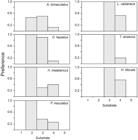We determined in this study the habitat preferences of seven native fish species in a regulated river in Southeastern Brazil. We tested the hypothesis that fishes differ in habitat preference and that they use stretches of the river differing in hydraulic characteristics and substrate type. We surveyed fishes in four 1-km long river stretches encompassing different habitat traits, where we also measured water depth, velocity, and substrate type. We investigated preference patterns of four Siluriformes (Loricariichthys castaneus, Hoplosternum littorale, Pimelodus maculatus, and Trachelyopterus striatulus) and three Characiformes (Astyanax aff. bimaculatus, Oligosarcus hepsetus, and Hoplias malabaricus), representing approximately 70% of the total number of fishes and 64% of the total biomass. We classified fishes into four habitat guilds: (1) a slow-flowing water guild that occupied mud-sand substrate, composed of two Siluriformes in either shallow (< 4 m, i.e., H. littorale) or deep (> 8 m, L. castaneus) waters; (2) a run-dwelling guild that occurs in deep backwaters with clay-mud substrate, composed of the Characiformes A. aff. bimaculatus and O. hepsetus; (3) a run-dwelling guild that occurs in sandy and shallow substrate, composed of T. striatulus; and (4) a fast-flowing guild that occurs primarily along shorelines with shallow mud bottoms, composed of H. malabaricus and P. maculatus. Our hypothesis was confirmed, as different habitat preferences by fishes appear to occur in this regulated river.
Ecological flow; Freshwater fishes; Habitat guild; River flow

 Thumbnail
Thumbnail
 Thumbnail
Thumbnail
 Thumbnail
Thumbnail
 Thumbnail
Thumbnail
 Thumbnail
Thumbnail




